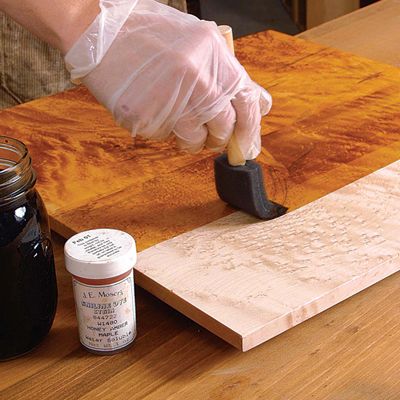Three Finishes for Bird’s-Eye Maple
Pop the figure of this wood using dyes, stains, glazes and topcoats
Synopsis: There are few woods that yield as contrasting appearances as bird’s-eye maple. Teri Masaschi, a professional finisher, shares three ways to finish this exquisitely figured wood: a natural look with oil and a topcoat; a darker version from a base of shellac and glazing stain; and an antique look from dye, stain, and shellac. Find tips for mixing and applying these various finishes.
From Fine Woodworking #163
I never would claim that working and finishing bird’s-eye maple are easy, but few woods can yield such contrasting appearances. At one end of the spectrum is the natural look, with a clear finish bringing out the wood’s three-dimensional quality. In complete contrast is the striking look of antique wood, where a century or more of oxidizing and accumulated patina gives it that certain glow and prominent grain. In between, there is the medium-tone appearance, with the eyes highlighted by the finishing process. Using a selection of dyes, stains, glazes and topcoats, I’ll show you how to achieve the appearance of your choice.
Good surface preparation is especially key to the desired outcome on bird’s-eye maple. This wood does have the tendency to tear out during planing. Using a wide-belt sander for larger surfaces and scraping for delicate details, you can eliminate most of the voids. Subsequent sanding with 120-, 150- and 180-grit paper on a random-orbit sander is all that is necessary to prepare the wood for its finish.
If you enjoy the clean, crisp look of unstained maple, wood selection is critical: There can be no sapwood, mineral streaks, or widely different colors of stock, because a natural finish can’t hide these discrepancies.
For a light finish, use Danish oil or Waterlox Original Sealer thinned with mineral spirits in a one-to-one solution. Pour a liberal amount on the wood and wet-sand with 400-grit paper or a sanding sponge, creating an oil-and-sawdust slurry. This will be driven into the eyes, leaving the surface smooth. One application should be sufficient. Additional coats can be added, but more oil makes the maple more yellow.
The topcoat should be nonyellowing like CAB acrylic lacquer, a pale solvent finish such as Behlen’s Water White Restoration Varnish, or a water-based lacquer or urethane. All clear coats should be gloss because the flatteners used to manufacture satin and semigloss coatings dull the wood’s appearance.
If a lower final sheen is desired, the gloss coat can be rubbed out. The idea behind this method is that the oil enhances the eyes, while the film coating creates a deeper and more dimensional surface than the oil alone can give.
For the full article, download the PDF below.
Fine Woodworking Recommended Products


Double Sided Tape

Veritas Micro-Adjust Wheel Marking Gauge





















Log in or create an account to post a comment.
Sign up Log in